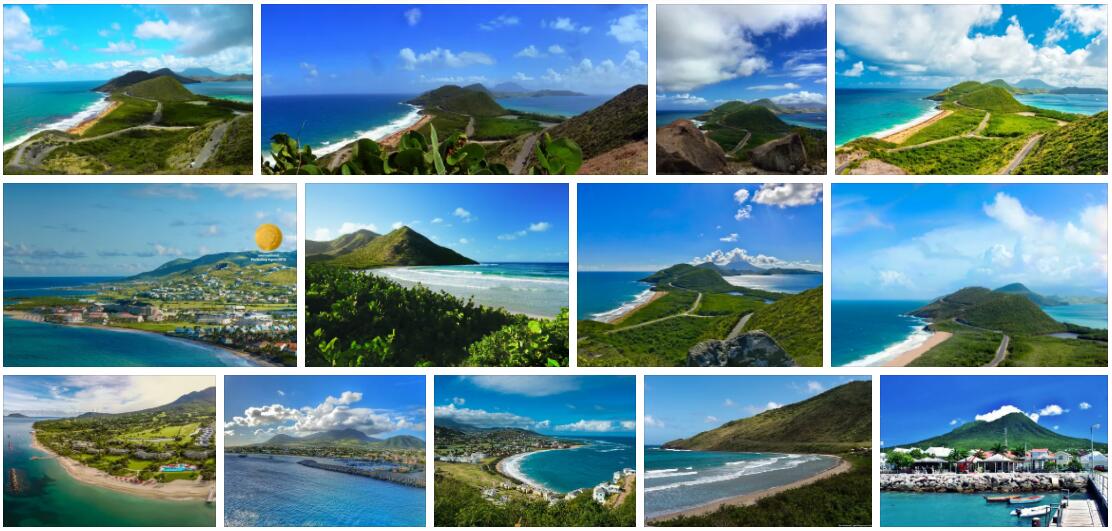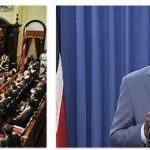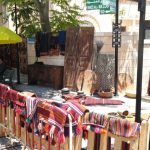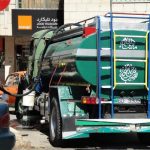| Federation of Saint Kitts and Nevis | |
| Official language | English |
| Capital | Basseterre |
| Form of government | Parliamentary monarchy in the Commonwealth |
| Area | 262 km² |
| Residents | 45,000 |
| Currency | East Caribbean dollar |
| Time zone | UTC -4 |
| License Plate | KAN |
| Internet TLD | .kn |
| Telephone area code | 001 (Source: ALLCITYCODES) |

Geography
The island state in the eastern Caribbean (officially: Federation of St. Kitts and Nevis, officially English: Federation of Saint Kitts and Nevis) consists of the two islands of St. Kitts (officially: St. Christopher) and Nevis, which belong to the Leeward Islands, an archipelago of the Lesser Antilles. The state borders on Antigua and Barbuda in the southeast, and the Netherlands Antilles in the northwest. See St. Kitts and Nevis country abbreviation.
Saint Kitts (169 km², 37 km long, up to 8 km wide) is separated by a 3 km wide strait from Nevis (93 km²). Both islands are of volcanic origin and characterized by mountains. On St. Kitts, a central mountain range runs from the northwest to the southeast, which is cut by deep gorges and reaches up to 1 156 m in Mount Liamuiga (formerly Mount Misery). There is a crater lake in the more than 700 m deep crater. The second highest mountain is Mount Verchilds at 893 m. Sulfur springs indicate continued volcanism, earthquakes also occur. In the south of St. Kitts there is a peninsula with many bays and white sandy beaches, while the sand of the beaches in the north of the island is black.
Nevis is located in the southeast of St. Kitts, here the extinct volcano Nevis rises up to a height of 985 m. The capital, Basseterre, is on the island of St. Kitts.
Climate
Saint Kitts and Nevis have a tropical climate, which is tempered by the northeast trade wind. The temperatures are almost constant all year round with an average of 27 °C. The annual rainfall is up to 1,500 mm on the windward east coast, but it can be more on the mountain slopes. Up to 800 mm are measured on the west coast. Much of the rainfall falls from July to November. Cyclones can also occur during this time.
Flora and fauna
In the drier regions of the islands there is sparse dry forest that had to give way to plantations and grasslands in many places. Evergreen rainforest with its great variety of plants grows on the mountain slopes. At higher altitudes, the rainforest changes into mountain forest.
Due to the island location there are only a few mammals on St. Kitts and Nevis, for example monkeys and mongooses were introduced. The bird life is rich in species, including various hummingbirds, parrots, pelicans and frigate birds. The coastal waters are very rich in fish.
Population
Around 45,000 people live in the island nation, a good three quarters of them on the larger island of St. Kitts. Around a third of the total population lives in the capital, Basseterre. The largest settlement on Nevis is Charlestown (1,800 residents). The average population density is 172 people per square kilometer. Population growth is low at 0.8% despite the significant birth surplus due to the high emigration rate.
According to COUNTRYAAH, 85% of the population are descendants of black African slaves, mulattoes (hybrids of blacks and Europeans) make up about 11% of the population, whites mostly of British origin about 2%. A small Asian minority lives on the islands. Most residents profess Christianity: around 34% are Anglicans, 30% Methodists, 9% Moravians and 10% Catholics.
The official language is English, Creole English is used as the colloquial language. The population’s medical care is good, and there are hospitals on both islands. The average life expectancy is around 72 years. School attendance is compulsory for children, so 97% of the island’s residents can read and write.
Political system
Based on the 1983 constitution, Saint Kitts and Nevis is a parliamentary monarchy within the British Commonwealth of Nations. The head of state is the British monarch Elizabeth II (since 1952), who is represented on the island by a governor general (since January 2013 Edmund Lawrence). The governor-general appoints the prime minister as head of government of the country, who is usually the leader of the strongest party in parliament (since July 1995 Denzil Douglas).
The legislature lies with the parliament, which consists of a chamber (national assembly) with 15 seats. Eleven of the MPs are elected by the people for a five-year term (eight from St. Kitts, three from Nevis), three are appointed by the Governor General, one member is “ex officio”.
The island state is divided into 14 municipalities. Nevis has its own island parliament (“Nevis Assembly”) and the status of a state with the right to later independence.
Economy
In the meantime, tourism has become the most important economic factor in the island state. The financial sector is also of increasing importance. The capital, Basseterre, is home to the Central Caribbean Central Bank and an Eastern Carbbean Securities Exchange for the eight Eastern Caribbean countries.
The long cultivation of sugar cane was supplemented by rice, jams, fruits and vegetables. Cyclones always lead to severe crop losses and large-scale destruction.
The industry is only moderately developed and focuses on the processing of agricultural products. The loss-making sugar industry was shut down in 2005. Machines, textiles and electrical goods (assembly from prefabricated parts) are also manufactured.
The USA is the most important trading partner for both exports (agricultural products) and imports.
The road network of both islands covers a total of around 320 km, half of which are paved. The islands are connected by ship and air traffic. Basseterre on St. Kitts is a deep-sea port and there is an international airport near the capital.
The currency is the East Caribbean dollar.







